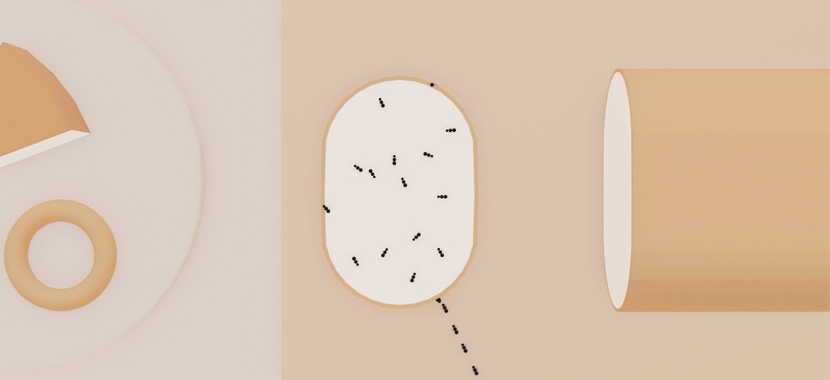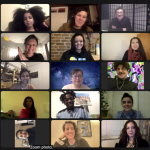Individual Giving: How to Successfully Cultivate Donors and Raise Funds
We help you determine who you should be sending appeals to, what you should send them, and when you should send them.
In the world of fundraising, success is often said to equal the Right Solicitor, asking the Right Prospect, for the Right Amount, at the Right Time, in the Right Way. Though this may sound intimidating, there is no secret formula for achieving such success.
Step one is understanding that fundraising can play a vital role in your artistic practice or emerging organization. Individual giving can help expand the possibilities of your work, while at the same time helping you to better understand who your supporters are and what may motivate them to support you.
To help you get started, we are sharing insights from Kimberly Goodis, Senior Officer of Individual Giving and Special Events, NYFA, on the Who, What, and When of individual giving.
“The most important thing for you to take away from this is the ability to determine which elements and methods work best for your project or organization, and how to adjust them to fit your needs and meet your goals,” says Goodis.
The Who
Donors are part of the audience for your work. Just as an artist defines their audience for sales or marketing purposes, they do so for donors.
If you’re just starting to fundraise, you’ll want to brainstorm prospects to approach. Your existing audience is the place to build or expand your donor prospects. Look into your practice and see who your existing audience is: consider attendees of past performances, gallery openings, etc; folks in your network of contacts including family, friends, and colleagues; those who’ve signed up for your email list; and any local businesses you frequent, vendors you work with, or community organizations you belong to.
“When we talk about the identification portion that’s what it is, it’s sitting down and making a list of who you are not thinking of. Who you have not yet brought into your artistic practice that you could be reaching out to,” says Goodis. This is especially notable as people who you have existing relationships with are going to be aware of your work and a commitment to your organization’s success. Having an email list and sending periodic updates will help you as you begin to build your fundraising efforts, as going back to this base of supporters is a helpful way to make fundraising less daunting.
If you already have a donor base, you’ll want to consider past donors going back 3-5 years. If you go back further than 5 years, these are people that you’ve likely lost connection with.
When you’re looking to increase your donor base and have experience fundraising for your project or organization, consider reaching out to lapsed donors. “A lapsed donor is someone who has given to you in the past three years but not in the last 12 months,” says Goodis. “They’ve shown they are committed and dedicated to your art, but they’re at risk for dropping off. So you want to make sure you know who those people are and take the time to look through and reach out to them.”
When you gather information on those who appreciate and support your work, set aside a regular time to put this information in a spreadsheet that you can use to track donations and engagement. “Looking at when and how donors have given to you and engaged with your work in the past is the best way to determine how to plan for future fundraising campaigns,” advises Goodis.
The format can be simple: First Name, Last Name, Email, Address Fields, and Giving History, so that you can make informed campaign asks. Set aside time on a regular basis to update this spreadsheet as new information comes in. If you see that Donor C donated $50 for the last two years, then you can consider asking them to give more ($75) since they seem committed to your cause.
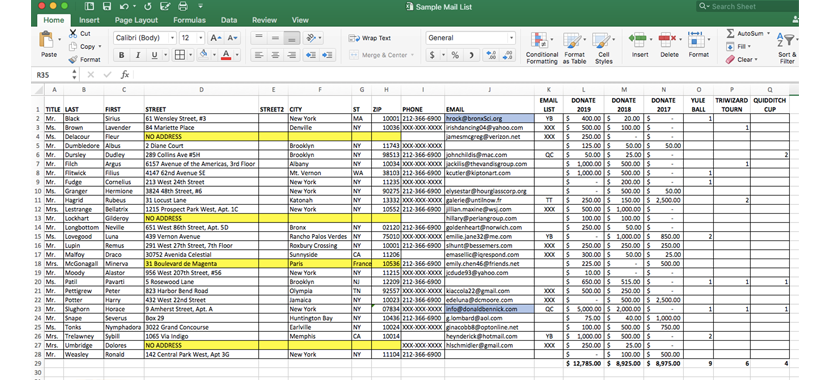
The What
A multi-pronged approach is key, as letters get lost in piles, emails get filtered into spam folders, and donors are more likely to respond after receiving information two or three times. Consider a combination of outreach via physical mail (letters, postcards, etc), eblasts and personalized emails, social media promotions, and more.
A compelling letter or email appeal looks professional, has recognizable branding (use your logo or letterhead design), addresses someone using their name (no generic Dear Friends!), and recognizes past giving if applicable. Goodis advises that “the day that you draft the letter is not the day you finish it,” and says that you should always have someone else proofread it. If you need inspiration, it’s OK to Google sample letters—as long as you don’t copy it word-for-word. Sample content ideas include summarizing your past year’s achievements and highlighting upcoming projects that you’re excited to share.
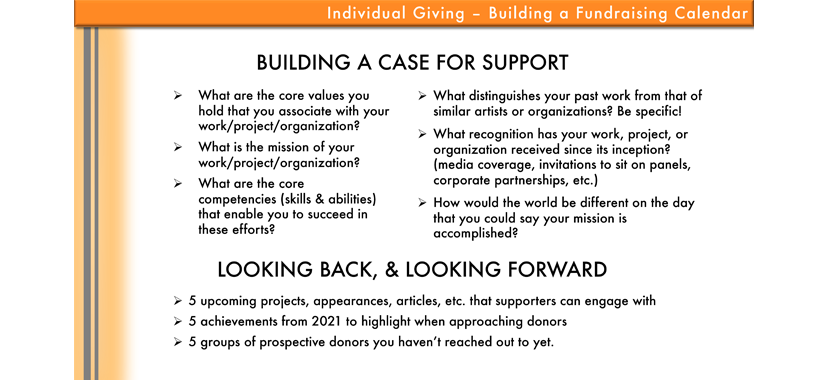
If you can identify specific levels of giving, you can help your donors decide how they want to support you and understand what their support means. In some cases, providing these options may inspire folks to give more. Say, for example, that you’re fundraising on behalf of a music organization: a $25 donation will cover a full set of Pirastro Violin Strings, $75 will cover one Menuhin Competition Entrance Fee, $150 will Rehair a Crescent A8035 Violin Bow ($150), and $250 will support a Complete Violin Refurbishment.
For physical mail, hand addressing and using real stamps helps get it seen. For emails, always include a link to donate online. When your email is ready, view it on multiple devices (desktop, mobile) and platforms (Gmail vs other email providers) to ensure it looks good and reads smoothly. Creative, attention-grabbing subject lines will also help with open rates.
The When
Goodis suggests that you consider a few factors when developing a fundraising plan to ensure that you’ll have the bandwidth to realistically meet deadlines and to ensure that other parts of your practice or personal life are attended to.
For example, if you know you’ll be applying for a particular grant in September, then you won’t likely have time to put appeal letters together at this time. If you anticipate becoming a new parent in June, then your focus won’t likely be on fundraising at that time. To get a sense of how this might look, visualize your fundraising plans in relation to your project or organization’s other activities in Google Calendar or on a physical 12-month calendar.
Also keep in mind federal holidays and other times that people are typically away and unresponsive. It is best focus your time and resources on outreach that will make the most impact! You can also inform your send dates and times by Googling for data on the best days and times for email opens and click-throughs. If you use an email marketing platform like Mailchimp, Constant Contact, or Moosend, use in-platform analytics to see how your content has performed in the past and to maximize your results in future sends.
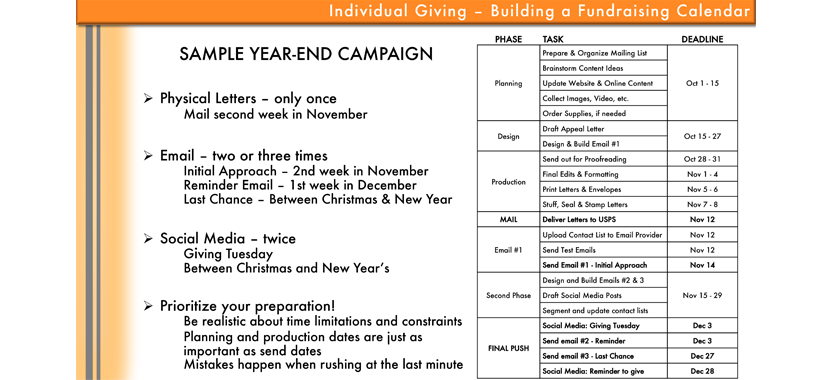
Consider the ebbs and flows of your calendar, what your available resources are, and when might strategically make sense to appeal to donors. If you notice that Donor A donated in March 2021, for example, you could make a note to reach out in March 2022 knowing that they gave at that time the previous year. Goodis also suggests taking into account the “halo effect,” which is contacting people after they’ve engaged with your work and while it is still fresh in their mind. Ideally they will have come away with a positive experience that
One approach to making more strategically-timed asks is by looking at your revenue and expense flow. For example: When is money being spent? Are you trying to buy new equipment or make a down payment on a new studio space? Factor in when those dollars are needed, and work backwards from there. In all cases, whether it is planning around a big donor event or a small appeal, you’ll want to coordinate different approaches working backwards from the dates that you’ve set on your calendar. Build in extra time, as Goodis notes that it always takes more time than anticipated to collect materials, draft and design pieces, and make final revisions.
Year-end giving is not to be discounted when mapping out your fundraising plan, as one third of all fundraising dollars are given in December. Says Goodis: You don’t want to ignore this, since it is the time when giving dollars are most in play.” In this case, you’ll probably want to start planning in October for things that are happening in November and December.
In Conclusion
“Like many things,” says Goodis, “consistency and perseverance are crucial for success.” If you’re consistent with your fundraising approach, you will then be able to identify the methods that work best for your creative practice or emerging organization.
If you’re looking for more advice on individual giving, check out our Individual Giving 101 post! In it, you’ll learn about the Donor Development Cycle and get five tips for folks who are new to fundraising.
– Compiled by Amy Aronoff, Senior Communications Officer
You can find more articles on arts career topics by visiting the Business of Art section of NYFA’s website. Sign up for NYFA News and receive artist resources and upcoming events straight to your inbox.

